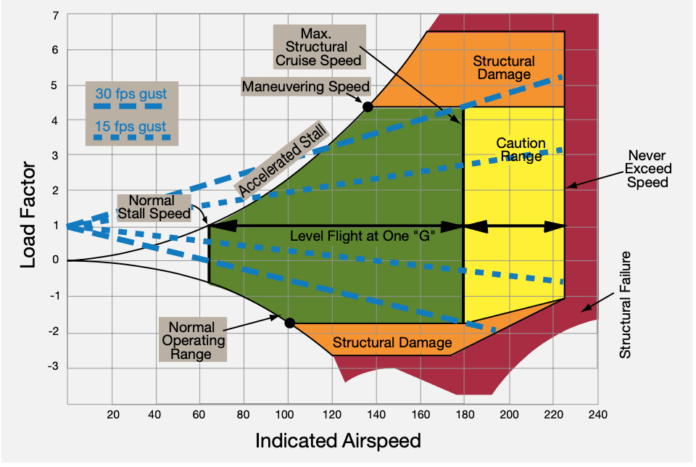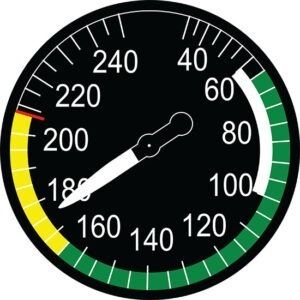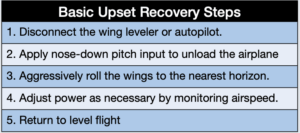
One instrument almost all aircraft have is an airspeed indicator. Of course, it’s important to know how fast we’re going, if for no other reason than bragging rights, and that’s true for airplanes, rotorcraft, gliders and even dirigibles (hot air balloons need not apply). Piston-powered personal airplanes, meanwhile, often have a bunch of color-coded markings on their airspeed indicator (ASI), denoting things like best single-engine rate of climb (VYSE) or minimum-control airspeed (VMC), when considering twins, and flap operating range (VFO) and normal operating range (VNO) for everything else, including the twins. There also are white, green and yellow arcs, plus another red line at the high end of the ASI when flying a twin. Single-engine airplanes just have the single red line at the top end, the never-exceed speed (VNE).
One thing piston-powered airplanes have that turbine-powered airplanes don’t? A yellow arc, which is the airspeed range between VNO and VNE. That’s for certification reasons: if you replace a piston engine and bolt on a turboprop, your new red line is at the top of the green arc, and the yellow arc is eliminated. For that matter, the green arc may be eliminated, also, leaving only the white one.
Primary students are correctly taught to not fly in the yellow arc unless the air is absolutely smooth. That’s a good personal rule, too, even though the airplane should be able to tolerate “slight” bumps without a problem. Lacking a G-meter, consider what a “slight” bump is to you and what it might be to a 50-year-old airframe. We typically think of a bit of light turbulence as a reminder to check airspeed, probably as we pull off some power to decelerate.

Important speeds like VS0 and VS1 are marked, as are VFE, VNO, VNE. Other important speeds, like maneuvering speed (VA), along with VX and VY, are missing because they change with weight. Some routine speeds, like VLO and VLE, also aren’t marked, as is the case for some non-routine values, like those for airframe ice.
IS THIS REALLY A PROBLEM?
The vast majority of us are flying machines that will never see airspeed in the yellow arc while straight and level. There are some piston-single drivers out there who swear they can cruise in the yellow arc, and they might be right. Chances are, however, if you’re in the yellow arc, the nose is down and you’re using a good bit of the available power. You’re coming down in a hurry, and you need to make sure that’s what you want to do. If not, you might be on the verge of losing control, and that’s a whole ’nuther problem, something we’ll get back to in a moment.
In addition to taking us to our destination faster, airspeeds in the yellow arc of course also take us closer to the red line, VNE. You’re the pilot, and you get to decide, but we suggest not allowing airspeed to edge too close to red line, even if the air is perfectly smooth. Three reasons: One, the air can get bumpy without warning. Two, slowing down to the green arc or even maneuvering speed (VA) if it does get bumpy will take longer. Three, the closer you are to the red line, the closer you are to the red line. Should something fail, or a control surface flirt with fluttering, you simply have less margin for error between you and that line.

What can you do in the yellow arc? Not much, as it happens. You certainly don’t want to make any sudden control inputs, because G-loading is G-loading, and the airframe likely doesn’t care if some additional G results from turbulence or a steep turn. Going mostly straight and usually in a descent offers the least risk. Keep your banks relatively shallow—standard rate is good; aerobatics are out of the question, thanks to being way above maneuvering or entry speed, though you may be flying something stressed for it.
SLOWING DOWN IN A HURRY
Those of us flying retractables are more likely to see the airspeed in the yellow than our fixed-gear siblings. When in the yellow arc and we need to get slowed down right now, retractable landing gear offers something a fixed-gear airplane likely can’t: fairly effective speed brakes. Your steed may have aftermarket speed brakes that pop out of the top of the wing, and they’ll work, too.
If you’re in the yellow arc, you’re very likely above VLO and VLE. Slowing down in such an emergency situation might call for dropping the gear for its extra drag. (Operating limitations presume you expect to make additional flights in this airplane. If that’s in doubt, there are no operating limitations.) Drop the gear to slow down and stabilize the airplane, then use an upset recovery checklist like the one below to return to controlled, level flight. Yes, you might lose a gear door, and the airplane might need a thorough inspection and landing-gear re-rigging. But it beats the alternative.
Whatever you do, whether in a retractable or fixed-gear airplane, do not extend the wing flaps. Doing that likely will overstress the mechanism, and probably the wing. There’s also the chance a wing flap could fail completely, departing the airplane while the opposite wing’s flap remains attached, creating a rolling moment that may be uncontrollable and yet another problem you’ll need to resolve.
If you’re not in that big a hurry to slow down, do it the old-fashioned way: smooth, coordinated power and pitch inputs. Then take a moment to recall why you were in the yellow arc in the first place.

As alluded to earlier, one reason you might find yourself in the yellow arc is because you’ve lost control. The airplane is pointed down at a relatively steep angle, the power setting is high and it’s probably entered a bank. This is no time for ham-handed flying. It is a good time to regret not obtaining any formal upset recovery training.
If you find yourself in a steepening spiral with airspeed building, the FAA’s Airplane Flying Handbook (FAA-H-8083-3C) recommends the steps in the table at right.



